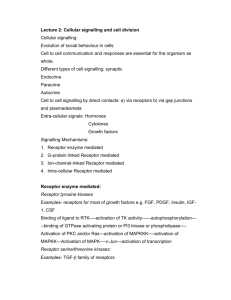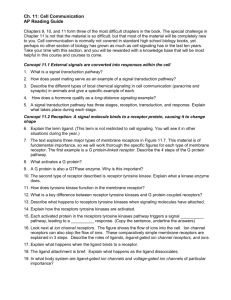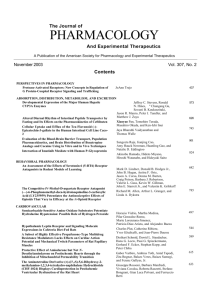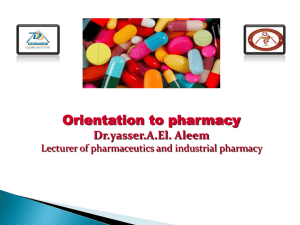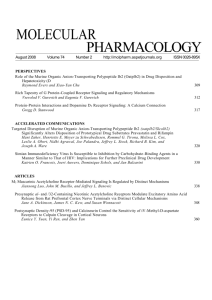- Department of Molecular Biology
advertisement
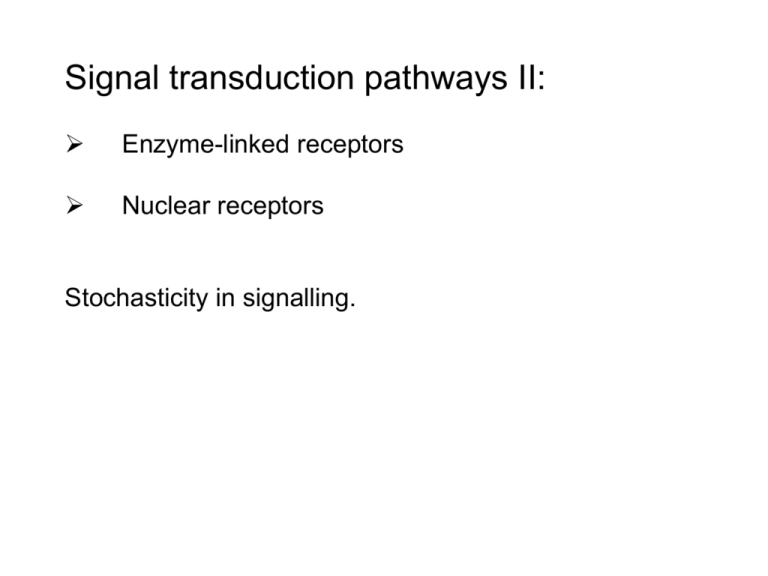
Signal transduction pathways II: Enzyme-linked receptors Nuclear receptors Stochasticity in signalling. Enzyme-linked receptors signalling through growth factors, hormones, cytokines acting locally at very low concentrations (10-9 – 10-11M) response is usually slow (min-hours) and requires many intracellular steps, leading to changes in gene expression 1. receptor tyrosin kinases (RTKs) 2. tyrosin kinases associated receptors 3. receptor serin/threonin kinases 4. histidin kinase associated receptors 5. receptor guanylyl cyclases 1. Receptor tyrosin kinases (RTKs) Ligands - EGF, PDGF, HGF, NGF, insulin, ephrins... Signalling through monomeric GTPases or through lipid modifications by PI3K Figure 15-52 Molecular Biology of the Cell (© Garland Science 2008) Table 15-4 Molecular Biology of the Cell (© Garland Science 2008) 1. Clusterring of receptors - ligand is a dimer (PDGF) - ligand is monomer but binds to TM heparan sulphate proteoglycans to form multimers (FGF) - clustering of TM ligand in a neighbouring cell (ephrins) - receptor is a multimer to start with (insulin) - ligand is monomer but binds two receptors simultaneously (EGF) Figure 15-16c Molecular Biology of the Cell (© Garland Science 2008) 2. induced proximity trans/auto phosphorylation Figure 15-53a Molecular Biology of the Cell (© Garland Science 2008) kinase-dead dimerization OK How would you create a DN form of enzyme associated receptor? Figure 15-53b Molecular Biology of the Cell (© Garland Science 2008) 3. transient assembly of intracellular signalling complexes • docking via SH2 domains or PTB domains • some are kinases (Src, PI3K) • some are adaptor proteins (Grb, IRS) that connect to a protein with enzymatic a. • some are inhibitors (e.g. c-Cbl, monoUbiq. and endocytosis) SH2 domain, PTB domain – recognize phosporylated tyrosines SH3 domain – recognizes proline rich sequences PH domain – recognizes modified lipids SH2 domain 4. spreading of the intracellular signalling events through the Ras superfamily of monomeric GTPases Only Ras and Rho signal through cell surface receptors Often tethered to membrane via lipid anchor Ras: hyperactive forms such as RasV12 • dominant, constitutively active • resistant to inactivation by GAP (no GTP hydrolysis) • Ras required for cell proliferation; mutant in 30% of human cancers RTKs activate a Ras-GEF or inhibit a Ras-GAP GEF – guanine exchange factor GAP – GTPase activating proteins Figure 15-19 Molecular Biology of the Cell (© Garland Science 2008) Signalling through Ras: EGFR signalling lesson from the Drosophila eye 760 ommatidia: 8 photoreceptor cells (R1-8) and 11 support cells, pigment cells, and a cornea Figure 15-56 Molecular Biology of the Cell (© Garland Science 2008) Dominant allele of EGFR, constitutively active EGFR required: • early for disc proliferation • spacing of R8 • survival differentiating cells • recruitment of all non-R8 ... but not for: • R8 differentiation • furrow progression Same for Ras boss sevenless Grb2 in mammals Figure 15-57 Molecular Biology of the Cell (© Garland Science 2008) What is the advantage to have many components on the way? Figure 15-60 Molecular Biology of the Cell (© Garland Science 2008) mitogen activated kinase (extracellular signal regulated kinase) MAP kinase modules - complexes of three protein kinases interconnected in series, often bound to a scaffold - after activation the MAPK-MAPKK interactions may be weakened, enabling MAPK to travel to the nucleus MAP kinase modules MAPKKK MAPKK MAPK Mitogenesis module Stress modules Binding to a scaffold reduces crosstalk BUT also avoids difussion and spreading of signal Signal amplification (of undocked kinases) input signal MEKK1 modules avoid spreading MKK4 MKK4 MKK4 MKK4 MKK4 MKK4 MKK4 MKK4 JNK JNK JNK JNK JNK JNK JNK output signal Downstream of MAPK – the effectors - mostly to promote proliferation and prevent apoptosis - substrates of MAPK: transcription factors, further kinases (MAPKAP kinases), also negative feedback loops through phosphorylation and activation of MAPK phosphatases or ras-GAPs Transctiption factors: - Ets family (Elk-1, TCF... after phosphorylation often bind another TF like SRF) - AP1(homo- or hetero-dimers of c-fos, c-jun, ATF2 and MAF through leucine zipper) - MEF2, MAX, NFAT..... MAPKAP kinases: - MAP kinase activated protein kinases - activation of proliferation and survival programs through phosphorylation of transcription factors or other regulatory proteins - p90 RSK = ribosomal S6 kinase MSK = mitogen and stress activated kinase MNK = MAPK interacting kinase EGFR in mammals – ERBB1(HER1) http://www.nature.com/scitable/topicpage/activation-of-erbb-receptors-14457210 ERBB family of tyrosin kinases 4 receptors ERBB1-4 (HER1-4) exists as homo or heterodimers different numbers of phosphorylation sites on their C-termini cellular outcome depends on the dimerization partners and ligands Ligands : growth factors (EGF family, NGF,TGF-a) Duration of response can influence the final outcome Neuronal precursor cell: EGF activation – peaks in 5 minutes, cells later divides NGF activation – lasts many hours, cell stops dividing and differentiates into neurons Positive and negative feedback loops Tyrosine specific phosphatases and GAPs inactivate Ras. 4. Signalling through the Rho family of monomeric GTPases RhoA, Rac, cdc48... - regulate actin and microtubule cytoskeleton - also regulate cell cycle progression, transcription, membrane transport - used by ephrin receptors but also by integrins, GF receptors, GPCRs… (Ras protein too) - activated by rho-GEFs (60 in human), inactivated by rho-GAPs (70 in human) - inactive rho bound in cytosol to guanine nucleotide dissociating inhibitor (GDI), preventing it to bind to GEF in the membrane Growth cone extension in axons through the guidance molecules ephrins The most abundant class of protein tyrosine kinases. http://www.bing.com/videos/search?q=axon+growth+cone&FORM=HDRSC3#view=detail&mid=FAC6 69D824BA3A6E32B3FAC669D824BA3A6E32B3 Enzyme-linked receptors 1. receptor tyrosin kinases (RTKs) 2. tyrosin kinases associated receptors 3. receptor serine/threonine kinases 4. histidin kinase associated receptors 5. receptor guanylyl cyclases Tyrosin kinases associated receptors Similar as receptor tyrosine kinases but the kinase is non-covalently bound to the receptor ligand kinase kinase kinase kinase Receptors for antigens on leucocytes, for cytokines, hormones, integrin receptors... Tyrosin kinases associated with receptors Src family: Src,Yes, Fgr, Fyn, Lck, Lyn, Hck, and Blk - cytoplasmic localization through lipid anchor and through association with receptors - SH2 and SH3 domains - can also be activated by some RTKs and GPCR FAK (focal adhesion kinase) JAK (Janus kinase) Src - first tyrosine kinase discovered, from the chicken Rous sarcoma virus (Peyton Rous, Nobel prize in 1966) = first transmissable agent inducing cancer - oncoproteins are gain of function cellular proteins (Bishop and Varmus ,1989) - v-src, c-src (receptor or other proteins) FAK (focal adhesion kinase) - associated with integrin receptors in focal adhesion points (places of cell contact with extracellular matrix) - recruit src, mutual phosphorylation and activation of cell survival and proliferation programme JAK JAK-STAT pathway - family of cytokine receptors, receptors for growth hormone and prolactine - stable association with JAK (Janus kinase, JAK1, JAK2, JAK3 and Tyk) - activated JAKs recruits STATs (signal transducers and activators of transcription), in the cytoplasm and phosphorylates them - phosphorylated STATs migrate to the nucleus and activate transcription Enzyme-linked receptors 1. receptor tyrosin kinases (RTKs) 2. tyrosin kinases associated receptors 3. receptor serine/threonine kinases 4. histidin kinase associated receptors 5. receptor guanylyl cyclases TGF-beta and BMP signalling transforming growth factor beta and bone morphogenetic protein - SMADs continuously shuttle between cytoplasm and nucleus during signalling (dephosphorylated in nucleus, rephosphorylated in cytoplasm) - secreted inhibitory proteins regulate the morphogen gradient: noggin and chordin (for BMP), follistatin (for TGFbeta) - inhibitory SMADs (SMAD6 and SMAD7) - compete for activating SMADs - recruits ubiquitin ligase Smurf to the receptor, promoting its internalization and degradation - recruits phosphatases to inactivate the receptor Enzyme-linked receptors 1. receptor tyrosin kinases (RTKs) 2. tyrosin kinases associated receptors 3. receptor serine/threonine kinases 4. histidin kinase associated receptors 5. receptor guanylyl cyclases Histidin kinase associated receptors - bacteria, yeast and plants, not in animals - bacterial chemotaxis: Default movement anticlockwise (straight) with occasional clockwise tumbling (stop). Chemotaxis receptors respond to various atractants and repelents - repellent activates receptor (tumbling), atractant inactivates it (going forward) - histidin kinase CheA (adaptor CheW) - regulator protein CheY binds motor and makes it rotate clockwise - intrinsic phosphatase activity of CheY (accelerated by CheZ) Attractant: (1) decreases the ability of the receptor to activate CheA (2) slowly (over minutes) alters the receptor so that it can be methylated by a methyl transferase, which returns the receptor’s ability to activate CheA to its original level (tumbling). Thus, the unmethylated receptor without a bound atractant has the same activity as the methylated receptor with a bound atractant, and the tumbling frequency of the bacterium is therefore the same in both cases. Bacteria adapts to certain concentration of atractant. Bacteria senses the difference in the concentrations of repellents and attractants, not the exact concentration! Enzyme-linked receptors 1. receptor tyrosin kinases (RTKs) 2. tyrosin kinases associated receptors 3. receptor serine/threonine kinases 4. histidin kinase associated receptors 5. receptor guanylyl cyclases ANPCR – ANP clearance receptor (endocytosis of ANP) pGC – particulate guanylyl cyclase receptor Receptor guanylyl cyclases Natriuretic peptide receptors – activated by ANP hormone produced by atrial cardiomyocytes, regulates blood pressure by relaxing smooth muscles in the veins; also BNP, CNP Intestinal peptide receptor guanylyl cyclases – activated by heat stable enterotoxin from E.coli and other gut bacteria, stimulates gut secretion and diarrhea; in mammals guanylin and uroguanylin Orphan receptor guanylyl cyclases – no known ligand cGMP NUCLEAR RECEPTORS NUCLEAR RECEPTORS Ligands: lipophylic molecules • Steroid hormones (from cholesterol: sex hormones, vitaminD, cortisol, ecdysone in insects) • Thyroid hormones (from tyrosine) • Retinoids (from vitaminA) Figure 15-13 Molecular Biology of the Cell (© Garland Science 2008) activation of transcirption inhibition of the receptor Types of nuclear receptors mineralokortikoid r. ultraspiracle glucocorticoid r. estrogen r. vitamin D retinoic acid androgen r. progesteron r. III. hepatocyte nuclear f. Video tutorial: http://www.nursa.org/flash/gene/nuclearreceptor/start.html Pardee et al.: A Handbook of Transcription Factors, Subcellular Biochemistry 52, 2011 peroxisome proliferator ecdysone Types of nuclear receptors Sever and Glass: Cold Spring Harb Perspect Biol 2013;5:a016709 Receptor for juvenile hormone (Met) new class of nuclear receptors inactive Met (juvenile hormone receptor) homodimer Met Met JH Tai JH Met JH binding to Met promotes dissociation of the inactive complex... ...and formation of active transcription factor heterodimer with Taiman Marek Jindra: Proc Natl Acad Sci U S A. 2011 Dec 27;108(52):21128-33, 2011 Pardee et al.: A Handbook of Transcription Factors, Subcellular Biochemistry 52, 2011 Tissue specificity of nuclear hormone recruitment Tissue specific transcription factors determine where NR bind on DNA Sever and Glass: Cold Spring Harb Perspect Biol 2013;5:a016709 STOCHASTICITY IN CELL SIGNALLING STOCHASTICITY IN CELL SIGNALLING all-or-none effect cell-cell variation cell noise Figure 15-24 Molecular Biology of the Cell (© Garland Science 2008) Reporter assay with a GFP trancriptional reporter after triggering a signalling pathway Stochastic response Sprinzak and Elowitz, Nature, 2010 ERK2 gene ERK2-YFP fusion in genomic locus YFP Response to EGF Cohen-Saidon C, Alon U et al.: Molecular Cell (2009) Different basal levels… …fold response after EGF stimulation similar between cells ‘Amount of ERK2 entering the nucleus is proportional to the basal level of nuclear ERK2 in each cell, suggesting a fold-change response mechanism.’ Cohen-Saidon C, Alon U et al.: Molecular Cell (2009) Estrogen signaling Weber’s law (1834) Human perception of light and sound is not based on absolute levels but on the magnitude of stimulus relative to the background levels. Why fold change rather than absolute level of detection? It might be easier for the cell to generate reliable fold changes than reliable absolute changes. It might serve as an adjustable noise filter. Absolute variations present when background level of stimulus is high tends to be higher than when background level is low. How is the fold change detected by the cell? Negative feed-forward loops. Incoherent feed-forward loop as a fold-change detector Consequence for regulated gene Z: Pulse of activity Incoherent feed-forward loop as a fold-change detector Alon U.: Mol Cell. 2009 Dec 11;36(5):894-9 Gene Z serves as a fold change detector. Dynamics of the output (amplitude and duration of the transcription of gene Z) depend only on the fold-changes in the level of the input signal, and not on the absolute levels of the input signal. In vivo ligand sensors

